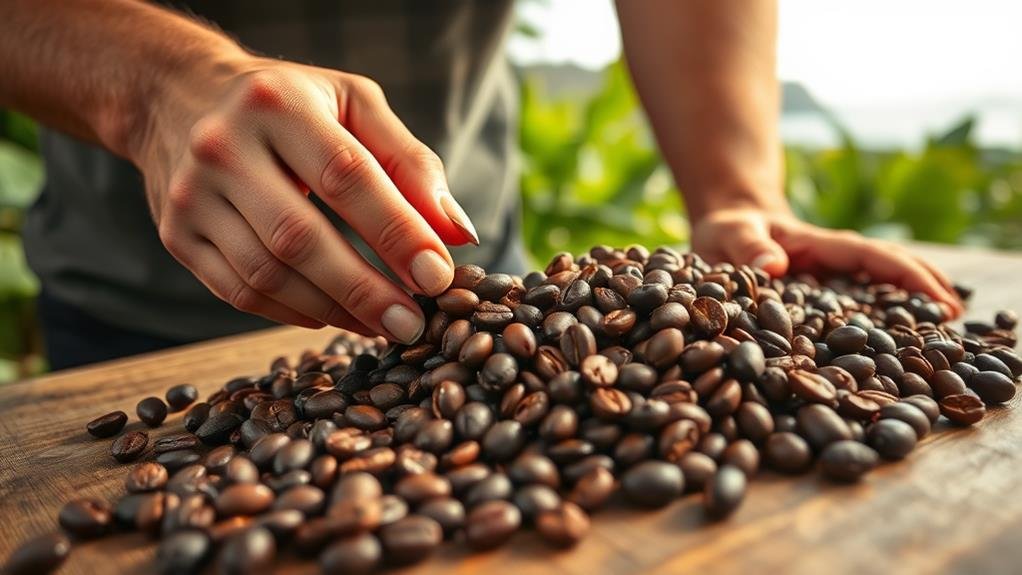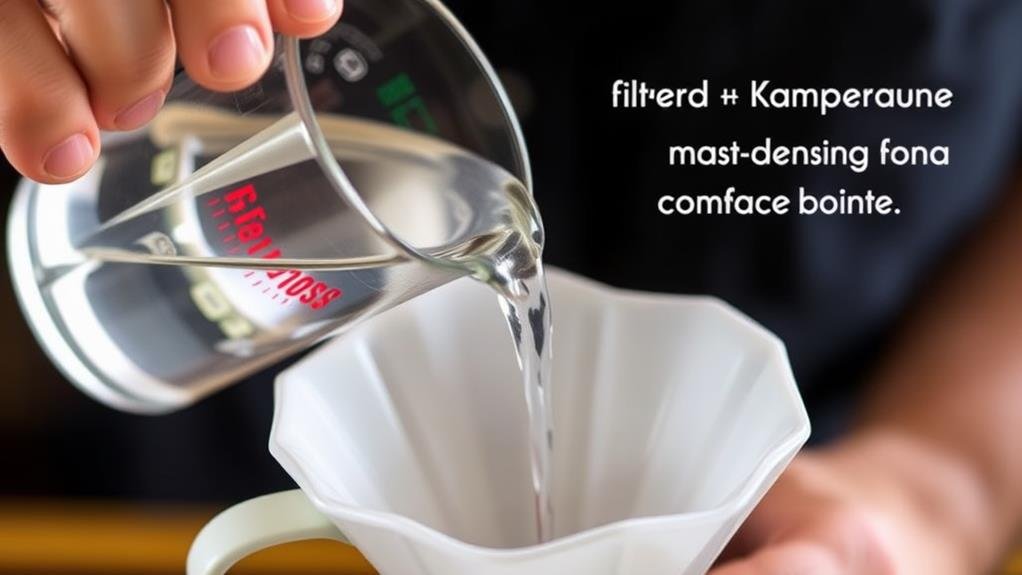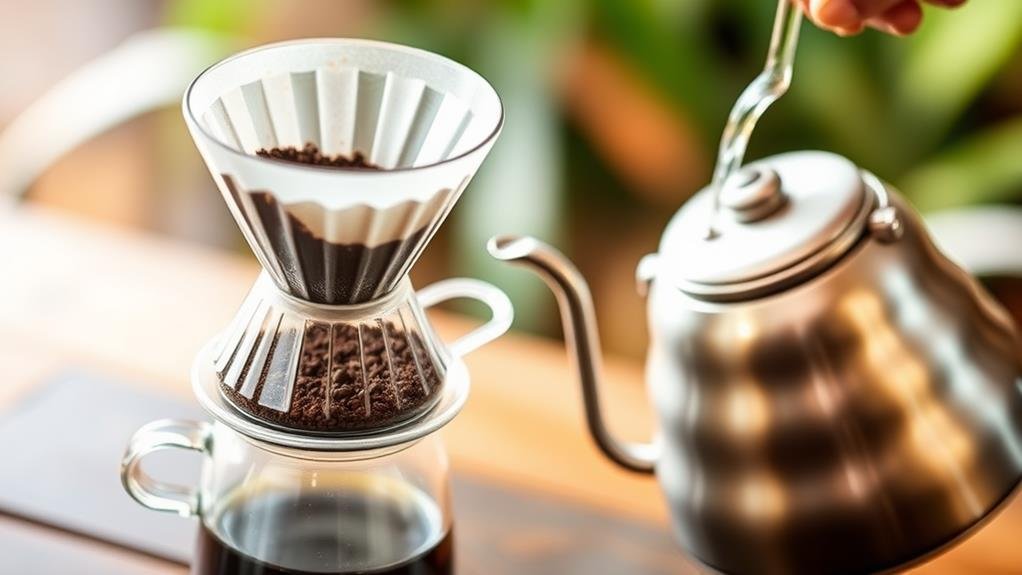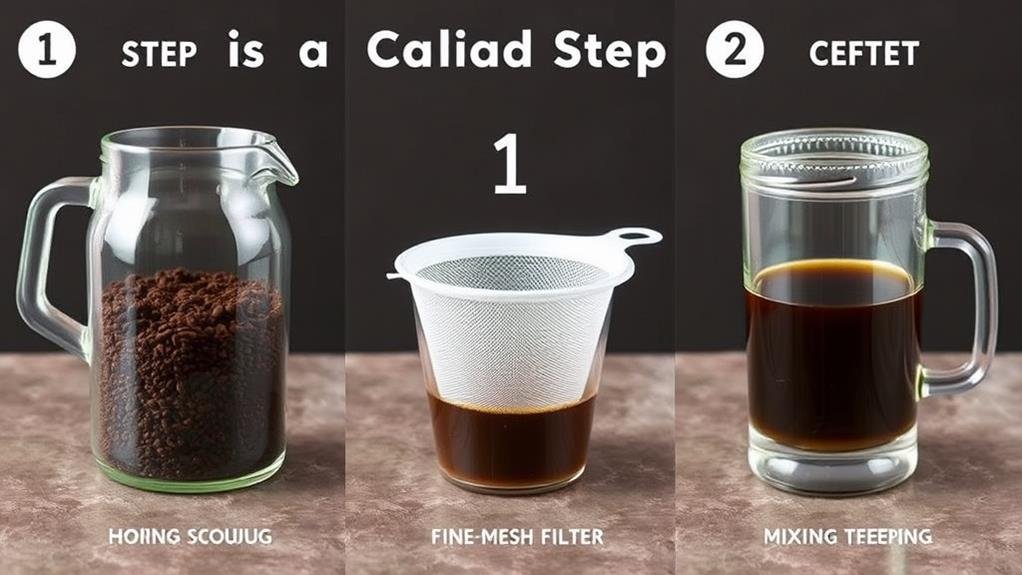As I savor the rich, smooth flavor of a perfectly brewed cup of Kona coffee, I'm reminded that it all starts with selecting the right beans. Choosing high-quality 100% Kona beans is essential for capturing the unique flavors and aromas that make this coffee so renowned. But it's not just about the beans; the grind size, brewing method, and even water temperature play pivotal roles in bringing out the best in your Kona coffee. If you're looking to elevate your coffee game and unleash the full potential of this Hawaiian gem, it's time to explore how to brew it just right.
Choosing Quality Kona Beans

When it comes to brewing exceptional Kona coffee, the journey begins with selecting high-grade beans. To guarantee you're getting the finest, look for 100% Kona beans. This classification is essential because it confirms that the beans are cultivated in the particular climate and soil conditions of Hawaii's Kona region, renowned for producing some of the world's finest coffee.
Consider the roast level that suits your taste preferences. Kona beans come in various roasts, from light to dark, each offering a distinct flavor profile. Lighter roasts tend to be more tangy and fruity, while darker roasts are richer and have a deeper, more intense flavor.
Check for the roast date on the packaging to confirm freshness. Newly roasted beans will have a more lively taste compared to older ones.
Read the label to comprehend the origin and quality of the Kona beans. Look for specific certifications or designations that indicate high quality and authenticity. By paying attention to these details, you can make sure that you are purchasing excellent Kona beans, which is vital for brewing a truly exceptional cup of coffee. This attention to detail will make all the difference in your brewing experience.
Grinding Techniques for Kona
When grinding Kona coffee, I find that the right technique makes all the difference. Blade grinders are affordable but often lack precision, while burr grinders offer consistent and precise grind sizes. Understanding how to select the right grind size for your brewing method is essential for achieving the perfect cup of Kona coffee.
Blade Grinder Tips
Using a blade grinder to grind your Kona coffee can be a cost-saving choice, but it requires some skill to achieve the best outcomes. One of the main hurdles with blade grinders is their tendency to produce uneven grind sizes, which can impact the taste of your coffee. To overcome this, grind in short bursts rather than continuously. This helps prevent overheating the coffee beans, which can also diminish the flavor.
For top-notch flavor extraction from Kona coffee beans, a consistent grind size is essential. While blade grinders may not be the ideal option for achieving this uniformity, there are steps you can take to enhance your results. Shake the grinder while it's in use to help evenly distribute the beans and achieve a more even grind.
Blade grinders work well for specific brewing methods like drip coffee makers, French presses, and pour-over techniques. However, if you're aiming for a precise, even grind that's necessary for extracting the best flavor from Kona beans, you might want to explore other grinder types. Nonetheless, with careful use and attention to technique, you can still savor high-quality coffee using a blade grinder.
Burr Grinder Precision
For best flavor extraction from your Kona coffee beans, investing in a burr grinder is a game-changer. Burr grinders offer precise and consistent grind sizes, which are essential for peak extraction. Unlike blade grinders, burr grinders produce uniform particles that enhance the flavor of your Kona coffee.
When choosing a burr grinder, you have two main options: flat or conical designs. Conical burrs are particularly known for their cooler grinding process, which helps preserve the delicate flavors of Kona beans. Here is a comparison of key features:
| Feature | Flat Burrs | Conical Burrs | Impact on Kona Coffee |
|---|---|---|---|
| Grinding Temperature | Higher | Lower | Cooler grinding preserves flavors |
| Particle Uniformity | Good | Excellent | Consistent particles for peak extraction |
| Grinding Time | Faster | Slower | More precise grind control |
| Maintenance | Easier | More Complex | Regular cleaning is essential |
| Cost | Generally Lower | Generally Higher | Worth the investment for specialty coffee |
Burr grinders are ideal for espresso and other specialty coffee brewing methods. Their ability to achieve consistent particles ensures that every cup of Kona coffee you brew is rich and flavorful. Investing in a burr grinder enhances the overall coffee brewing experience and allows you to fully appreciate the unique qualities of Kona beans.
Grind Size Selection
Selecting the accurate grind size is vital for revealing the full flavor of your Kona coffee. Different brewing methods require specific grind sizes to extract best flavors, so understanding this is important.
For French press and cold brew methods, a coarse grind is ideal. This allows the coffee grounds to steep properly, ensuring a rich and smooth flavor without over-extraction. Medium grind works well for traditional drip brewing and pour-over techniques, providing a balanced extraction that brings out the nuanced flavors of Kona Coffee.
If you're aiming for a concentrated shot, a fine grind is suitable for espresso brewing. The finer grind allows for high-pressure extraction, resulting in that intense espresso experience you love.
Using the right grind size guarantees that your Kona Coffee is brewed to perfection. Whether you prefer the robust taste of a French press or the concentrated richness of an espresso, selecting the accurate grind size will make all the difference in your cup. By choosing the appropriate grind for your brewing method, you'll be able to fully enjoy the unique flavors that Kona Coffee has to offer.
Ideal Water Quality and Temperature

When it comes to brewing Kona Coffee, the quality and temperature of the water are key elements that can make or break the flavor profile. Using filtered water is strongly recommended to avoid unwanted flavors that might be introduced by public water systems. Filtered water helps guarantee a pure and neutral taste, which is essential for bringing out the full flavor of Kona Coffee.
The ideal temperature for brewing Kona Coffee is between 195 and 205 Fahrenheit. This range allows for best extraction without burning the coffee grounds, which can happen if boiling water is used. Boiling water should be avoided at all costs because it can result in a bitter taste that detracts from the coffee's natural flavors.
Using the right water quality and temperature can significantly influence the coffee's flavor profile. By selecting filtered water and maintaining an ideal temperature, you can guarantee that your Kona Coffee tastes as rich and smooth as it should. This attention to detail will enhance your brewing experience and allow you to fully appreciate the unique qualities of Kona Coffee. His guidance will help you achieve a perfect cup every time you brew.
French Press Brewing Method
To brew Kona Coffee using the French press method, I start by preparing a coarse grind of my coffee beans. This coarse grind is essential because it allows for the utmost extraction of rich flavors from the Kona Coffee beans. After grinding, I use an ideal ratio of 1 ounce of coffee for every 4 cups of water. This balance guarantees that the coffee is neither too strong nor too weak, perfect for bringing out the full-bodied taste that Kona Coffee is known for.
I then add the ground coffee to my French press and pour the water over it. The mixture is allowed to steep for 4 minutes, which gives the coffee enough time to release its flavors into the water. After the steeping process, I slowly press the plunger down to separate the grounds from the liquid.
The French press brewing method is a popular choice for enjoying Kona Coffee because it extracts rich flavors without filtering out any of the coffee's natural oils. This results in a brew that retains its full-bodied taste and aromatic qualities, making each sip a delightful experience. By following these steps, you can enjoy your Kona Coffee at its finest using this simple yet effective brewing method.
Pour-Over Brewing Process

I prefer the pour-over brewing process for its precision and control over the extraction of flavors from Kona Coffee. This method allows for a nuanced and balanced cup, which is ideal for showcasing the rich flavor profile of Kona Peaberry coffee.
To brew coffee using the pour-over method, start by placing a paper filter in your V60 dripper. Grind your Kona coffee beans to a medium grind size, similar to kosher salt, for peak extraction. Heat water to 205°F; this temperature guarantees the best extraction of flavors from the coffee grounds.
Pour the heated water slowly over the coffee grounds in circular motions to evenly saturate all of them. This process typically takes between 2.5 to 3 minutes, allowing for a balanced brew. The pour-over method eliminates the need for a drip coffeemaker, giving you full control over each step of the brewing process.
Espresso Brewing Guide
Espresso brewing with Kona coffee demands precision and the right techniques to bring out its intense, rich flavors. To start, you need fine grind dark roasted Kona beans. This guarantees ideal extraction and a full-bodied taste.
When it comes to brewing, while traditional espresso machines are ideal, you can also use the French press method at temperatures below 200°F to avoid bitterness. Here's a quick guide to get you started:
| Step | Description |
|---|---|
| Grind | Fine grind dark roasted Kona coffee |
| Water | Filtered water for balanced flavors |
| Tamping | Even tamping in the portafilter for consistent extraction |
| Brew Time | 25-30 seconds for a rich and flavorful shot |
Tamping down the coffee grounds evenly in the portafilter is essential for consistent extraction during brewing. Using filtered water is also vital as it helps maintain balanced flavors in your espresso shot.
A well-brewed espresso shot should take 25-30 seconds to extract, producing a rich and flavorful result. By following these steps, you can enjoy a perfect cup of espresso made from Kona beans every time. Remember, precision and attention to detail are fundamental in espresso brewing.
Cold Brew Brewing Instructions

Brewing cold brew coffee with Kona beans involves steeping coarse-ground coffee in cold water for 24 hours to extract a smooth, less acidic flavor profile. To start, use a coarse grind of Kona coffee beans to ensure ideal extraction during the cold brewing process. This texture allows the right amount of flavor to be extracted without becoming overly bitter.
Next, combine the coarse-ground coffee with cold water in a brewing container. Let it steep for 24 hours, which may seem long but is necessary for achieving that distinct cold brew taste. After the steeping time, strain the cold brew concentrate using a filter pouch or any straining method to remove the coffee grounds.
The resulting concentrate can be stored in the refrigerator for up to 4 days, making it a convenient and invigorating coffee option. To customize your cold brew, you can add milk or other sweeteners and serve it over ice for a delightful and chilled coffee experience. This flexibility allows you to tailor your cold brew to your taste preferences, whether you like it sweetened, creamed, or enjoyed straight. Enjoying cold brew with Kona beans is a great way to appreciate the unique flavor profile of these premium coffee beans.
Proper Storage and Maintenance
After enjoying your cold brew made with Kona coffee, it's vital to focus on how you store the beans to maintain their quality. Proper storage is essential for preserving the freshness and flavor of Kona coffee. To protect from light, heat, and moisture, store your Kona coffee in an airtight, opaque container at room temperature. This helps in maintaining the beans' quality and flavor profile.
If you plan to refrigerate or freeze your Kona coffee, consider using degassing valve bags or airtight containers. Before sealing the container, squeeze out any excess air to prevent moisture absorption and maintain freshness. However, avoid storing Kona coffee directly in the refrigerator or freezer as this can cause condensation and lead to flavor degradation.
Conclusion
Now that you've got the hang of brewing Kona coffee, it's time to put your skills to the test. Remember, practice makes perfect, so don't be afraid to experiment until you find your ideal cup. With high-quality beans and the right techniques, you'll be brewing like a pro in no time. When in doubt, just think of it as a piece of cake – it might take a little effort, but the result is well worth it. Enjoy your delicious Kona coffee

